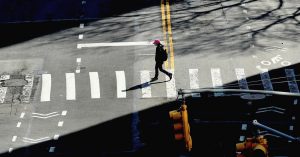New York City today is like Wuhan, the city in central China with the first known Covid-19 outbreak, in late January.
And now that the United States is facing its own epidemic, federal and state authorities are experimenting with many of the same tactics adopted by the Chinese authorities: vast lockdowns, sweeping travel restrictions, bans on public gatherings and mandatory social-distancing measures.
But they are omitting one crucial element of what helped make Wuhan’s response effective in the end: a form of centralized quarantine.
In late January, the authorities in Wuhan were essentially doing what New York authorities are doing today: For fear that hospitals would become overloaded with patients, they discouraged some sick people, especially the mildly sick, from even seeking hospital care. Only, there is a serious problem with that approach: Sending thousands of sick people home all but ensures that they will infect other people in their households.
That’s what happened in Wuhan. And that is almost certainly what is happening in New York — possibly other American cities, too — right now.
The Chinese authorities, after recognizing the danger, quickly shifted tactics. Starting in early February, they built a series of quarantine centers, including roughly 20 facilities with about 1,000 beds each, just in Wuhan, a city of about 11 million people. The mildly sick were sent there for two weeks, while patients with serious complications were to be treated in hospitals.
Not only did the measure help ease the burden on hospitals; it curbed transmission of the virus from the lightly ill to relatives, roommates, friends or anyone else sharing their living spaces.
In Wuhan, the move was critical to breaking the back of the epidemic in less than two months: Those mass isolation centers have all closed down.
New York, like other American cities, is now trying to rapidly build up capacity to handle large numbers of patients. A temporary field hospital is scheduled to open on Monday in the Jacob Javits Convention Center in Manhattan, with a capacity of nearly 3,000 beds; it is being set up to treat non-Covid-19 patients so as to allow mainstream facilities to focus on patients infected with the new coronavirus. Four other temporary medical facilities — with a total of 4,000 beds — are currently being planned for New York’s other boroughs.
Yet new confirmed cases in the city numbered roughly 3,500 on Sunday alone. Faced with such a rapid increase, the lightly ill in the city will almost certainly be asked to keep staying at home — which only risks spreading the virus even more.
There is another solution, though: Using the tens of thousands of hotel rooms in the city, many of which currently are empty, to house people who have tested positive for the coronavirus or — given the dearth of available tests — who display mild Covid-19-like symptoms. Let’s turn hotels into temporary quarantine quarters.
Patients would be put up for free for 14 days, the standard recommended period of self-isolation. Food could be delivered. Nurses could be stationed at the hotels to check on the people who are quarantined, in particular to ensure that anyone who develops more severe symptoms can be rapidly taken to a hospital. Any member of one’s household who subsequently tested positive could move in.
Congress recently authorized hundreds of millions of dollars of stimulus spending to combat the epidemic. Some of those funds could help finance a crash campaign to help hotels — not only in New York, but throughout the country — convert themselves into quarantine centers.
At least four New York City hotels have already volunteered to provide rooms to medical personnel or patients who aren’t critically ill; Andrew Cuomo, the governor of New York State, has praised their gesture. Now, state and city authorities must actively encourage more such efforts by directly compensating hotel owners who agree to turn their premises into quarantine facilities.
Los Angeles County authorities experimented with just that last week, opening a quarantine center at a Sheraton hotel in Pomona, with plans for more emergency arrangements at other hotels. Chicago is also reported to be planning on reserving some 1,000 hotel rooms in the city to ease pressure on hospitals.
New York City authorities should also organize to have public health officials train hotel employees about how to safely interact with self-isolated individuals: how to deliver meals, disinfect rooms or handle people with pneumonia like symptoms. (Taiwan has prepared a detailed guide for such procedures. Why not New York?)
Some people are sure to resist any move toward centralized quarantining: It does raise difficult questions about individual rights. For example, should the measure be mandatory, as it was in China? Would the police be made to enforce it, and how?
But there is good reason to believe that people who are ill with Covid-19, or who fear that they might be, would voluntarily quarantine themselves outside their own homes, even if the authorities didn’t require them to: Many are terrified of infecting family members, friends and others. So why not make it possible for them to undergo quarantine without endangering anyone else, all the while using resources already on hand? Let’s convert New York’s hotels — including yours, Mr. President — into temporary self-isolation facilities.
Carl Minzner is a professor of law at Fordham University, in New York, who specializes in Chinese law and politics.
The Times is committed to publishing a diversity of letters to the editor. We’d like to hear what you think about this or any of our articles. Here are some tips. And here’s our email: [email protected].
Follow The New York Times Opinion section on Facebook, Twitter (@NYTopinion) and Instagram.



















